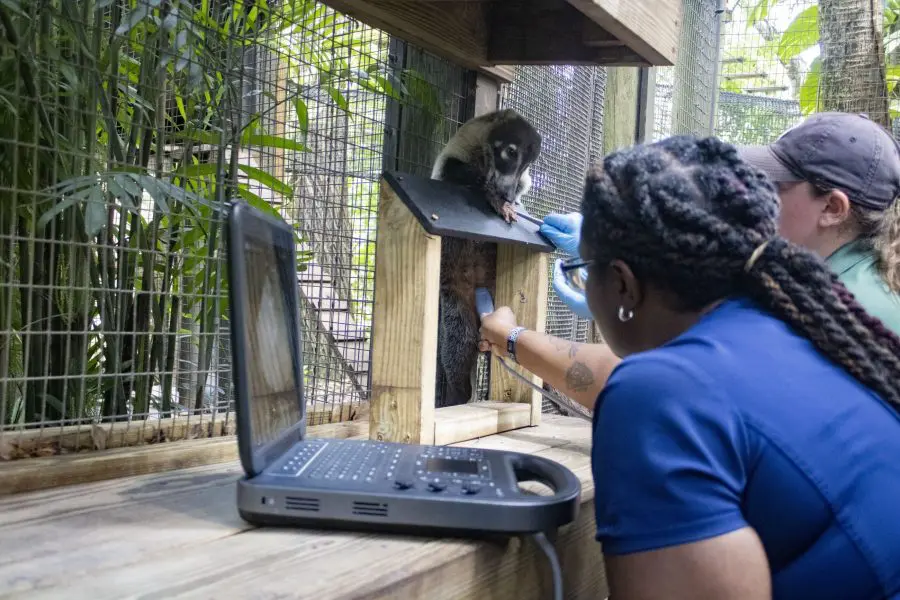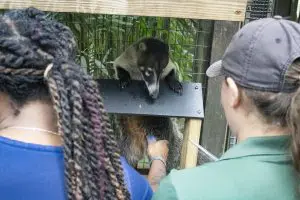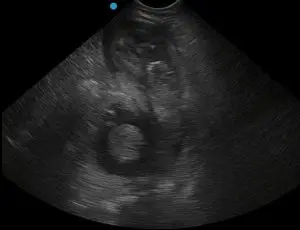

Our white-nosed coati habitats in Rainforest Revealed may be a little quieter over the next few weeks – but not for too long. Two of our female coatis, Sky and Rita, are pregnant!
Sky and Rita have been moved to behind-the-scenes spaces to give birth and care for their young with minimal stress and disturbance. Once the kits are born, the mothers and their young will stay behind-the-scenes for a few weeks until the time comes to begin slow introductions with the rest of the band.
 Our animal care team has been working with all our female coati to participate in ultrasounds and radiographs, allowing us to learn about their pregnancies fairly early on! It took about 2 months to fully train the ultrasound behavior, and their keepers maintain the behavior by training it a couple times a week even before they started breeding season.
Our animal care team has been working with all our female coati to participate in ultrasounds and radiographs, allowing us to learn about their pregnancies fairly early on! It took about 2 months to fully train the ultrasound behavior, and their keepers maintain the behavior by training it a couple times a week even before they started breeding season.
This species can have anywhere from two to five babies, so there will hopefully be a lot of squeaks and sniffs coming from their habitat soon!
We’ve shared the work we’ve done over the years to establish a breeding band of coatis at our Zoo, bringing in five young coati since 2021. Our animal care team has also imported coati from reputable organizations to be brought to other AZA-accredited facilities, increasing the population. This was to establish a more sustainable, healthy genetically diverse population of coati in our fellow AZA-accredited facilities. Our director of animal programs, Lauren Hinson, manages the white-nosed coati studbook for AZA-accredited facilities.
 Our animal care team is so thrilled at this early success! It’s been about 7 years since there was a birth in the white-nosed coati populations in North American AZA-accredited facilities.
Our animal care team is so thrilled at this early success! It’s been about 7 years since there was a birth in the white-nosed coati populations in North American AZA-accredited facilities.
“This has been a combination of animals who are aging out and no longer reproductive but also some management strategies that weren’t working for breeding success,” Lauren said.
Female coatis only breed from about 2-8 years old during specific breeding seasons. Understanding this species’ natural history, our animal care team also established our female coati – Rita, Sky, Romi and Agave – in their own habitat, with our male – Tito – in a separate space for most of the year.
“It isn’t normal natural history to keep male/female pairings,” Lauren said. “This has caused many pairs to be unsuccessful with breeding as they tend to get a more sibling-type relationship in that setup. Most zoos keep a pair, but we are trying to change that.”
When the time comes, the kits will likely move to other zoos to establish coati bands elsewhere. In addition to helping maintain zoo populations, SSPs are safeguards for species in their natural range. Wild populations of white-nosed coati are decreasing due to large-scale habitat loss and in some areas, hunting. Here are a few tips to help:
Brevard Zoo is an independent, not-for-profit organization that receives no recurring government funding for our operating costs. Your generous support enables us to continue to serve our community and continue our vital animal wellness, education and conservation programs.